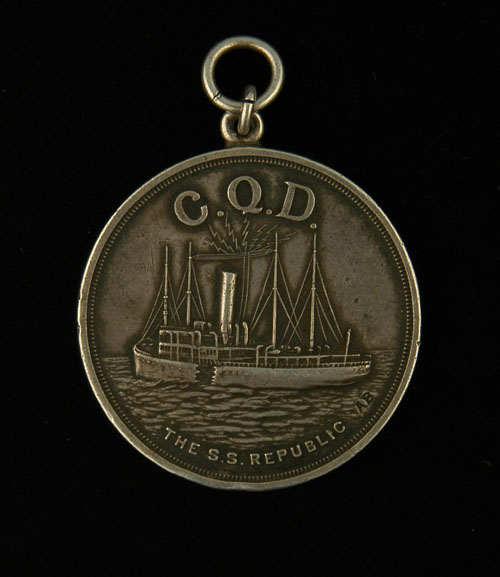
Auction: 6017 - Orders, Decorations, Campaign Medals & Militaria
Lot: 188
C.Q.D. Medal, silver, 45mm, some minor edge bruising, otherwise good very fine and scarce Estimate £ 240-280The White Star Line´s R.M.S Republic was built in 1903 at the Harland and Wolff shipyards, Belfast. With a length of 570 feet, and a displacement of 27,220 tons, and equipped with electric light and refrigeration machinery the Republic was one of the largest, most modern, luxurious passenger vessels afloat. With her 12 water-tight compartments she was considered "practically unsinkable." In the early morning of January 23 1909 the Republic, sailing from New York to Gibraltar, collided with the Italian liner S.S. Florida in fog off the island of Nantucket, Massachusetts USA. The White Star Line´s R.M.S. Baltic responded to the C.Q.D. call sent out by radio. Three passengers died in the collision; the remaining passengers from the Republic were transferred, first to the less-damaged Florida, and then, on her arrival, to the Baltic. The Republic sank the next day whilst under tow to New York. The saloon passengers of the two White Star Liners subscribed to a fund to provide medals to the crews of the three ships involved, in recognition of the fact that they saved more than 1,700 lives. Three silver-gilt medals were given to the three captains, with the officers and crew given silver and bronze medals. This was the first occasion on which the C.Q.D. distress call had been sent by wireless transmission. The Wireless Operator aboard the Republic, Jack Binns, was given a hero´s welcome when the survivors reached New York, but later declined the post of Wireless Operator aboard the R.M.S. Titanic. The R.M.S. Republic was found by Captain Martin Bayerle in 1981. She lies approximately 50 miles south of Nantucket Island, and is rumoured to contain one of the greatest treasures ever lost at sea. In addition to a $265,000 U.S. Navy Payroll (consigned to the U.S. Navy Atlantic Fleet at Gibraltar), a relief fund destined to aid the survivors of an earthquake in Italy, and the personal jewellery and other valuables of her wealthy passengers, it is suspected that she also carried to the bottom of the sea a politically sensitive and secret shipment of gold that had been consigned to the Czar of Russia: a $3,000,000 five-ton shipment of American Gold Eagle coins. The total value of this hoard in today´s prices would be in the region of fifty million pounds. C.Q.D. was the first distress signal adopted for radio use. It was announced on 7.1.1904 by the Marconi International Marine Communication Company, and became effective, for Marconi installations, 1.2.1904. The letters C.Q. sound phonetically very much like the phrase ´seek you´. Land telegraphs had traditionally used C.Q. to identify messages of interest to all stations along a telegraph line, and C.Q. had also been adopted as a general call for maritime radio use. However, in landline usage there was no general emergency signal, so the Marconi company added a D, generally thought to have stood for distress, to C.Q. in order to create its distress call. Although used worldwide by Marconi operators, C.Q.D. was never adopted as an international standard. At the second International Radiotelegraphic Convention, held in Berlin in 1906, Germany´s Notzeichen distress signal of three-dots, three-dashes, three-dots was adopted as the international Morse code distress signal. This distress signal soon became known as S.O.S.
Sold for
£280




